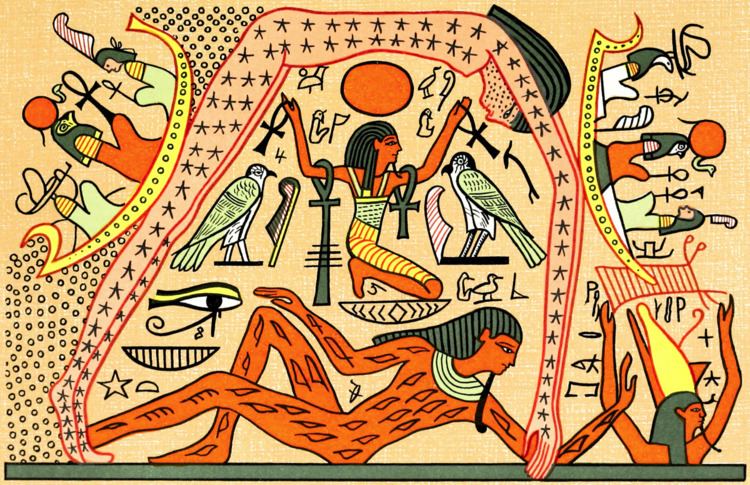Genre History | ||
 | ||
Similar Carlsberg papyrus, Book of Caverns, Book of Gates, Litany of Re, Book of the Heavenly Cow | ||
The Book of Nut (original title: "The Fundamentals of the Course of the Stars") is a collection of ancient Egyptian astronomical texts, also covering various mythological subjects. These texts focus on the cycles of the stars of the decans, the movements of the moon, the sun and the planets, on the sundials, and related matters.
Contents
This title was given to the book because of the depiction of the sky goddess Nut arching over the earth in some copies of the text. She is supported by the god of the air Shu. The Book of Nut texts include material from different periods of Egyptian history.
The original name of the book, 'The Fundamentals of the Course of the Stars', was discovered by Alexandra von Lieven in one of the manuscript fragments, and published in 2007. One of the big themes of the Book of Nut is the concept of sunrise as the mythological rebirth.
The book of nut
The texts
There are 9 different copies of the book of various dates. Three copies are found on monuments, and 6 more are found in the papyri of the 2nd century AD coming from the temple library in ancient Tebtunis, a town in the southern Faiyum Oasis. These include texts both in hieratic and demotic; some parts are also written in hieroglyphs.
Three texts of the Book of Nut are preserved on monuments: the tomb of Ramses IV, The Cenotaph of Seti I at the Osireion in Abydos, and the tomb of the noblewoman Mutirdis (TT410) of the 26th Dynasty . These monumental copies are written in hieroglyphs.
The Tebtunis textual material is currently scattered all over the world due to its complex excavation and acquisition history. There are several thousand fragments of unpublished papyri held by various museums that are being evaluated by scholars.
The best manuscripts are the demotic Carlsberg papyri 1, and 1a; they were written by the same scribe. Other manuscripts are mostly fragmentary.
There are substantial differences between all these copies, indicating that the textual tradition of the Book of Nut was still very much alive even in the 2nd century AD.
History of scholarship
The early Egyptologists gave a lot of attention to the astronomical parts of the Book of Nut. First available for modern research was the material from the tomb of Ramses IV, which included the astronomical painting of Nut and the list of the decans. The text was first used by Jean-François Champollion and Ippolito Rosellini, later copied by Heinrich Brugsch. A new edition was issued in 1990 by Erik Hornung.
In 1933, The Cenotaph of Seti I at the Osireion in Abydos was discovered. This was important because this version represents the oldest text. Adriaan de Buck's translation of the cryptographic sections of the Book of Nut significantly advanced the studies.
In 1977, Jan Assmann published another relevant text from the tomb of noblewoman Mutirdis, dating to the 26th Dynasty.
Some important new material has been published since 2007.
The dates of composition
Most likely, the Book of Nut text evolved over a long period of time going back before the time of Seti I. The astronomical data included in the decan list below the body of Nut point to the 12th dynasty, the time of Sesostris III.
There are two different decan lists that cannot be reconciled, so one of them must be secondary. According to von Lieven, the Middle Kingdom data is secondary, and she suggests that the earlier list goes back to the Old Kingdom.
